|
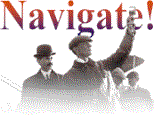


Meanwhile:
How about a
little music?
We have a selection of tunes that were
popular during the first days of aviation, performed by Sue Keller, courtesy the
Ragtime Press:
Want to ask a question? Tell
us something? Arrange a showing of one of our airplanes? Ping:
mailto:[email protected]
| |
"Before the Wright
Brothers, no one in aviation did anything fundamentally right. Since the Wright Brothers,
no one has done anything fundamentally different."
--
Darrel Collins, US Park Service,
Kitty Hawk National Historical Park
 o say simply that the Wright Brothers invented the airplane doesn't
begin to describe their many accomplishments. Nor is it especially accurate. The first
fixed-wing aircraft -- a kite mounted on a stick -- was conceived and flown almost a
century before Orville and Wilbur made their first flights. The Wrights were first to
design and build a flying craft that could be controlled while
in the air. Every successful aircraft ever built since, beginning with
the 1902 Wright glider, has had controls to roll
the wings right or left, pitch the nose up or down,
and yaw the nose from side to side. These three controls --
roll, pitch, and yaw -- let a pilot navigate an airplane in all three dimensions,
making it possible to fly from place to place. The entire aerospace business, the
largest industry in the world, depends on this simple but brilliant idea. So do
spacecraft, submarines, even robots. o say simply that the Wright Brothers invented the airplane doesn't
begin to describe their many accomplishments. Nor is it especially accurate. The first
fixed-wing aircraft -- a kite mounted on a stick -- was conceived and flown almost a
century before Orville and Wilbur made their first flights. The Wrights were first to
design and build a flying craft that could be controlled while
in the air. Every successful aircraft ever built since, beginning with
the 1902 Wright glider, has had controls to roll
the wings right or left, pitch the nose up or down,
and yaw the nose from side to side. These three controls --
roll, pitch, and yaw -- let a pilot navigate an airplane in all three dimensions,
making it possible to fly from place to place. The entire aerospace business, the
largest industry in the world, depends on this simple but brilliant idea. So do
spacecraft, submarines, even robots.
More important, the Wright Brothers changed the way we view our
world. Before flight became commonplace, folks traveled in just two dimensions,
north and south, east and west, crossing the lines that separate town from town, nation
from nation. Seen from above, the artificial boundaries that divide us disappear.
Distances shrink, the horizon stretches. The world seems grander and more interconnected.
This three-dimensional vision has revealed a universe of promises and possibilities. The
world economy, our awareness of our environment, and space exploration are all, to some
degree, the results of the inventive minds of the Wilbur and Orville Wright.
Here, in brief, is their story. To explore any part of it in
greater detail, click on the section titles below or left.
|
Click
on the pictures to enlarge them.
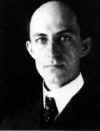
Wilbur Wright, 1867 to 1912
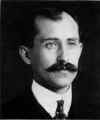
Orville Wright, 1871 to 1948

Orville Wright executes a right turn in the 1902
Wright glider -- the first aircraft ever to have roll, pitch, and yaw
controls.

Wilbur shows the world how it's done in one of his
first public flights, Le Mans, France, 1908.
|
|
An
Unusual Childhood
Wilbur and Orville were the sons of Milton and Susan Wright and members of a
warm, loving family that encouraged learning and doing. Milton was a bishop in the
United Brethren Church, and was often away from home on church business. But he wrote
hundreds of letters home, and often brought back presents from his trips, exposing his
children to the world beyond their horizon. In 1878, he brought home a rubber band-powered
helicopter, and young Wilbur and Orville immediately began to build copies of it.
In 1884, Bishop Wright moved his family to Dayton, Ohio, the political center of the
United Brethren Church. About the same time, his wife Susan fell ill with tuberculosis.
Wilbur, just out of high school, put off college and nursed his sick mother. Orville began
to lose interest in school and learned the printing business. Susan Wright died in the
summer of 1889, the same year that Orville dropped out of high school to open his own
print shop.
|

Wilbur Wright, age 12, in 1878.

Orville Wright, age 8, in 1878.
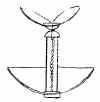
In 1929, Orville drew this sketch of the toy
helicopter his father had given to him many years earlier.
|
Career Choices
In 1890, Wilbur joined Orville in the printing business, serving as editor for The
West Side News, a weekly newspaper for their west Dayton neighborhood. It was
modestly successful, and the Brothers began a daily, the Evening Item, in 1891.
However, they couldn't compete with larger, more established daily newspapers, and after a
few months they went back to being simple job printers.
In 1894, Wilbur and Orville were caught up in the bicycling craze that swept the
nation. To augment the income from their printing trade, they began repairing and selling
bicycles. This soon grew into a full-time business, and in 1896 they began to manufacture
their own bikes. The Wright Cycle Company returned a handsome profit, but the brothers
cared little about the money. They were already thinking about trading their wheels for
wings.
|

The Wright home in Dayton, Ohio. about 1895.

The Wright Brothers weekly newspaper, the West
Side News.

A Wright-built "Van Cleve" bicycle.
|
Inventing the Airplane
In 1896, the newspapers were filled with accounts of flying machines. Wilbur and
Orville noticed that all these primitive aircraft lacked suitable controls. They
began to wonder how a pilot might balance an aircraft in the air, just as a cyclist
balances his bicycle on the road. In 1899, Wilbur devised a simple system that twisted or
"warped" the wings of a biplane, causing it to roll right or left. They tested
this system in a kite, then a series of gliders.
They made their first test flights at Kitty Hawk, North Carolina, on the shores of the
Atlantic where the strong winds helped to launch the gliders and the soft sands helped to
cushion the fall when they crashed. Their first two gliders, flown in 1900 and 1901,
failed to perform as the Wrights had hoped. The gliders did not provide enough lift nor
were they fully controllable. So during the winter of 1901-1902 Wilbur and Orville built a
wind tunnel and conducted experiments to determine the best wing shape for an airplane.
This enabled them to build a glider with sufficient lift, and concentrate on the problem
of control. Toward the end of the 1902 flying season, their third glider became the first
fully controllable aircraft, with roll, pitch, and yaw controls.
During the winter of 1902-1903, with the help of their mechanic, Charlie Taylor, the
Wrights designed and built a gasoline engine light enough and powerful enough to propel an
airplane. They also designed the first true airplane propellers and built a new, powered
aircraft. Back in Kitty Hawk, they suddenly found themselves in a race. Samuel P. Langley,
Secretary of the Smithsonian Institution, had also built a powered aircraft, patterned
after a small, unmanned "aerodrome" he had flown successfully in 1896. To add to
their frustrations, the Wrights were delayed by problems with their propeller shafts and
the weather, giving Langley time to test his aircraft twice in late 1903. Both attempts
failed miserably, however, and Langley left the field to the Wrights. On December 17,
1903, Wilbur and Orville Wright made the first sustained, controlled flights in a powered
aircraft.
Back in Dayton, Ohio, the brothers found they had much to do to perfect their
invention. While the 1903 Wright Flyer did indeed fly, it was underpowered and difficult
to control. They established the world's first test flight facilities at Huffman Prairie,
northeast of Dayton (today, the site of Wright Patterson Air Force Base). For two years
they made flight after flight, fine tuning the controls, engine, propellers, and
configuration of their airplane. At first, they could only fly in a straight line for less
than a minute. But by the end of 1905, they were flying figure-eight's over Huffman
Prairie, staying aloft for over half an hour, or until their fuel ran out. The 1905 Wright
Flyer was the world's first practical airplane.
|

Wilbur Wright built this kite in 1899 to test a new
type of control system for an aircraft. It worked.

The controls on the 1900 glider worked well, but the
wings did not produce enough lift.

The 1901 glider was such a disappointment that Wilbur
almost gave up.
The 1902 glider, designed with the Wrights own wind
tunnel data, was the Wright's first successful flying machine.

The 1903 Flyer 1, the Wright brothers first powered
aircraft, made four short flights on December 17, 1903.

The 1904 Flyer 2, a virtual copy of the Flyer 1, flew
the first circles and figure-8s, but it was very difficult to control.

The 1905 Flyer 3 could fly until it's fuel ran out and
land "without crashing," as Wilbur so bluntly put it. It was the
first practical airplane.
|
|
Showing
the World
After the 1905 flying season, the Wrights contacted the United States War Department,
as well as governments and individuals in England, France, Germany, and Russia, offering
to sell a flying machine. They were turned down time and time again -- government
bureaucrats thought they were crackpots; others thought that if two bicycle mechanics
could build a successful airplane, they could do it themselves. But the Wright
persisted, and in late 1907, the U.S. Army Signal Corps asked for an aircraft. Just
a few months later, in early 1908, a French syndicate of businessmen agreed to purchase
another.
Both the U.S. Army and the French asked for an airplane capable of
carrying a passenger. The Wright brothers hastily adapted their 1905 Flyer
with two seats and a more powerful engine. They tested these modifications
in secret, back at Kitty Hawk, North Carolina for the first time in several
years. Then the brothers parted temporarily -- Wilbur to France and Orville
to Virginia.
In 1908 and 1909, Wilbur demonstrated Wright aircraft in Europe, and Orville flew in
Fort Meyer, Virginia. The flights went well until Orville lost a propeller
and crashed, breaking his leg and killing his passenger Lt. Thomas Selfridge.
While Orville recuperated, Wilbur kept flying in France, breaking record
after record. Orville and his sister Kate eventually joined Wilbur in
France, and the three returned home to Dayton to a elaborate
homecoming celebration. Together, Orville and Wilbur returned to Fort Meyer with a new Military Flyer and completed the U.S. Army trials. A few months
later, Wilbur flew before over a million spectators in New York Harbor --
his first public flight in his native land. All of these flights stunned and
captivated the world. The Wright Brothers became the first great celebrities
of the twentieth century.
|

The Wrights adapted the Flyer 3 to carry two people in
1908.

During the demonstration flights of 1908 and 1909,
the Wrights still used a derrick and weight to catapult their airplane
into the air.

The Wright Military Flyer above Fort Meyer,
Virginia.

During a routine flight, Orville lost a prop and
dived to the ground. The crash broke his leg and killed his passenger.

The Wrights returned to Fort Meyer the following year,
completed the U.S. Army trials without incident, and delivered the first
military aircraft.
|
The Airplane Business
As their fame grew, orders for aircraft poured in. The Wrights set up airplane factories and
flight schools on both sides of the Atlantic. Unfortunately, once they had demonstrated their aircraft in public, it was easy for
others to copy them -- and many did. The Wrights were dragged into time-consuming,
energy-draining patent fights in Europe and America. The most bitter legal battle was with
Glenn Curtiss, who, as part of his defense, borrowed Langley's unsuccessful aircraft from
the Smithsonian Institution and rebuilt it to prove that the Aerodrome could have
flown before the Wright Flyer. The ruse didn't work -- Curtiss made too many
modifications to get Langley's aircraft in the air and the courts ruled in favor of the
Wrights. Yet although the case resolved the Wright/Curtiss dispute, it left an
enduring resentment between the Wrights and the Smithsonian.
Outside the courtroom, the world seemed no friendlier to Wilbur and Orville. The
aircraft business was uncertain and dangerous. Most of the money to be made was in
exhibition flying, where the audiences wanted to see death-defying feats or airmanship.
The Wrights sent out teams of pilots who had to fly increasingly higher, faster, and more
recklessly to satisfy the crowds. Inevitably, the pilots began to die in accidents and the
stress began to tell on the Wrights. Additionally, their legal troubles distracted them
from what they were best at -- invention and innovation. By 1911, Wright aircraft were no
longer the best machines flying.
In 1912, Wilbur Wright, worn out from legal and business problems, contracted typhoid
and died. Orville, his heart no longer in the airplane business, sold the Wright Company
in 1916 and went back to inventing.
|

The Wrights built a factory in Dayton to build aircraft
-- this is the assembly room.

Orville and some of the students he taught to fly at the
Wright Flying School.

Orville tests a new airplane (a Model E) above the
Wright Company hangar at Huffman Prairie.

Exhibition pilots made low altitude passes to thrill the
spectators in the grandstands.

Occasionally, these flights ended in tragedy. Here a
Wright airplane has crashed into the stands.
|
A Long Twilight
Patent fights and business troubles behind him, Orville Wright built a small laboratory
in his old West Dayton neighborhood. Here, he worked on anything that caught his interest.
He did some aeronautical work, helping to develop a racing airplane, guided missile, and
"split flaps" to help slow an aircraft in a dive. But he also worked on an
automatic record changer, a toaster, and children's toys. In short, he tinkered.
His fame as the co-inventor of the airplane endured, however, and he put it to good
use. He was on the original board of the National Advisory Committee for Aeronautics
(NACA), and served longer than any board member since. (NACA later became the National Air
and Space Administration, or NASA.) He helped oversee the Guggenheim Fund for the
Promotion of Aeronautics, an effort that helped America recapture the technological lead
in aviation during the 1930s. He also worked tirelessly to help unknown inventors bring
their ideas to market.
And he continued a long, running battle with the Smithsonian that had begun with
their duplicity in the Curtis patent suit. After the First World War, the Smithsonian
exaggerated Langley's contributions to aeronautics while seeming to belittle the Wrights.
Friends of Orville set the record straight, but the Smithsonian kept on. In retaliation,
Orville sent the 1903 Wright Flyer, the airplane in which he and Wilbur had made the first
powered flights at Kitty Hawk, to the Science Museum of London in England. In the
1930s, Charles Lindbergh, the first aviator to fly from New York to Paris nonstop,
attempted to mediate the feud, but to no avail. It wasn't until 1942 that Orville Wright's
friend and biographer, Fred Kelly, convinced the Smithsonian to back down and publish the
truth. That done, Orville sent word to England that the Flyer was to be brought home to
America. Its return was delayed by the Second World War, but it was finally returned in
1948.
Orville's Wright last big project was, fittingly, an aircraft. He helped to rebuild the
1905 Flyer III, the first practical airplane, which he and Wilbur had perfected at
Huffman Prairie. This was put on display at Deeds Carillon Park in Dayton, Ohio in 1950,
but Orville did not live to see the ceremony. He died of a heart attack in 1948 while
fixing the doorbell at his home. |

Orville stands beside a Model B in 1916, just after he
sold the Wright Company.

Orville's laboratory in West Dayton.
Orville sat on the boards of several institutions and
corporations as an advisor. He's seen here with the Guggenheim Fund Board.
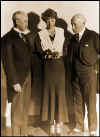
He also seemed to be a perpetual guest of honor. He's
shown here with Amelia Earhart at the Franklin Institute.
Orville standing beside a huge Curtiss-Wright radial
engine in 1941.
The 1903 Wright Flyer 1 finally comes home in 1948.
|
Back to the top
|
